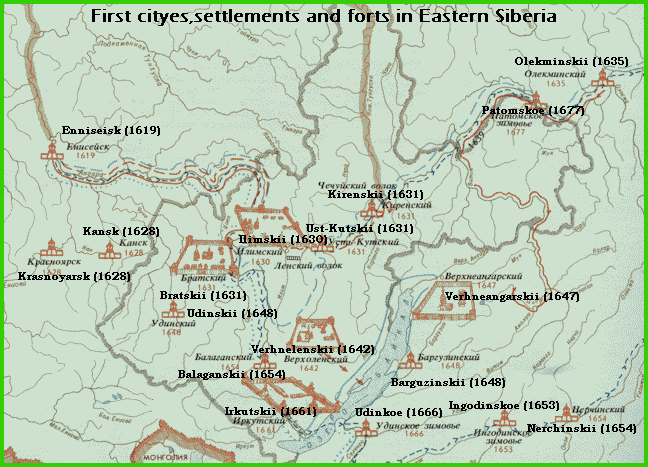![]()
Outstanding Russians with ties to Irkutsk's history include Ermak, the first general-governor of East Siberia H. H. Muravyov-Amursky, the renowned statesman M. M. Speransky, "Russian Columbus" Grigori Shelekhov, and the famous historian A.Schapov, whose lectures amazed Saint Petersburg students.
Pioneers, Cossacks, missionaries, deportees, rich merchants who could compete with the spiritual flower of Russia, the nobility - each of these added to the glory and the honor of their city - Irkutsk. Talented workers who gave such a distinctive and unique face to the capital of East Siberia have tirelessly worked for their descendants.
The mellow chime of hundreds of bells met Irkutsk's guests on holydays at the beginning of the twentieth century. There were about forty Orthodox churches in Irkutsk in those days, not all of which have survived to the present. Nowadays for your first encounter with the city, a native would likely take you to the first church, that from which the city's genealogy is counted--Spask Church, slim and graceful. This Church has been called "The swan song of ancient Russian architecture" by specialists.
For three and a half centuries Irkutsk has lived a long-suffering life, undergoing
many severe trials. The worst of these trials may have been in the so-called
"Black Year" of 1879, which was marked by a devastating fire. Three
days and nights the city was a blazing inferno, and ten long years were needed
to rebuild it! People from all over Siberia and Russia raised it anew from the
ashes, and after ten years A.P.Chehov could say: "The city of Irkutsk is
dandy. It is quite a European city...."
Irkutsk merchants, who always were great patriots and philanthropists, were among those who worked the hardest in rebuilding the city and making it prosperous. They built hospitals, orphanages, colleges, libraries and churches. People said that if they had wanted to, they could have built a glittering road of silver roubles that stretched all the way to Moscow.
The great wealth amassed by the local merchants contributed greatly to the unique character of Irkutsk architecture, because when it came time for them to build their homes, they called on the best architects in Russia. And it sometimes happened that a talented architect left the first memories of himself in far Siberia and only later gained fame in Moscow and St.Petersburg.
The whimsical brick house of the millionaire brothers Vtorov, who had 1500 employees and owned famous shops in many cities of Western Europe, China, and Mongolia, was designed in Neorussian style. You can see it today at the former Ivanovsaya Square. Another millionaire, Trapeznikov, ordered his private residence to be built after the pattern of the famous Louvre in Paris. And the great architect Qwarengi considered it an honor to fulfill the order of the powerful merchant Sibyryakov. Built from his design, the White House was called by contemporaries "the Oriental Palace" becouse of its blinding richness.
Sukachyov - the mayor and founder of the Irkutsk art museum - built his private residence, complete with an art gallery, in exotic oriental style on the outskirts of the city. But after the big fire, Bolshaya street, Amurskaya street and Laninskaya street became the architectural showcase of the city, with buildings designed not only by celebrities from the capital but also by talented locall architects: Rozen, Rassushin, Razgildeev, Alexeev, Vasilyev.
But the capital of East Siberia became famous not only for its brick buldings.
The areas of the city where wooden buildings dominate are equally beautiful,
and there you can find a deeper national heritage. The majority of Siberian
cities are proud of their wood architecture, but only in Irkutsk can you see
the most artistic handcrafted wooden elements. Baroque platbands spanned by
graceful volutes and decorated with splendid bouquets,
darkened carved tulips over windows, fans and sunbeams adorning platbands, slim
irises covering house walls, figured carvings along the edges of roofs--all
these and more were used by carpenters to decorate Irkutsk houses. Even if you
know only a little of the mystery of wooden lace work, sightseeing in Irkutsk
along old streets can take you on a fantastic journey into the culture of the
ancient Slavs.

The past is the stairway to the future. Nowadays the city of Irkutsk is one
of greatest economic and cultural centers in the eastern part of the country.
Many years ago the modern stately city expanded and grew beyond its former outskirts.
The presence of an historic Polish Roman-Catholic church, a Tatar mosque, and
a Jewish synagogue show that from the very beginning the city was multicultural
and multinational.
Formely cut off from central Russia by the rocky Urals, this distant Siberian
city is now connected by living threads with all the world. The 100th anniversary
of the East-Siberian steamship-line was celebrated in 1985. There are direct
routes connecting the city with the Mongolia, Japan and China, as well as many
routes within the country.
Despite the fact that Irkutsk is well over three hundred years old, the average age of today's population is only 31.6 years. It is a city of youth and students. There are 36 institutes and colleges and 9 vocational schools. Every day 166,646 pupils attend school in the city. In 1949 the East-Siberian branch of the Russian Academy of Science founded 9 research institutions and a regional Economy Department.
Irkutsk is also a theatrical city. In the evenings bright lights are switched
on at the entrances of five theatres. There are 15 cinemas and 34 libraries
that house a total of 2.5 million books.
If you want to come and visit us in Irkutsk, keep in mind that the coldest month is January(-20.9 C) and the hottest month is July (+20.6 C). However, for our guests the Russian-style cordiality of our ancient city always radiates the warmth and the light of its rich spiritual culture.
![]()